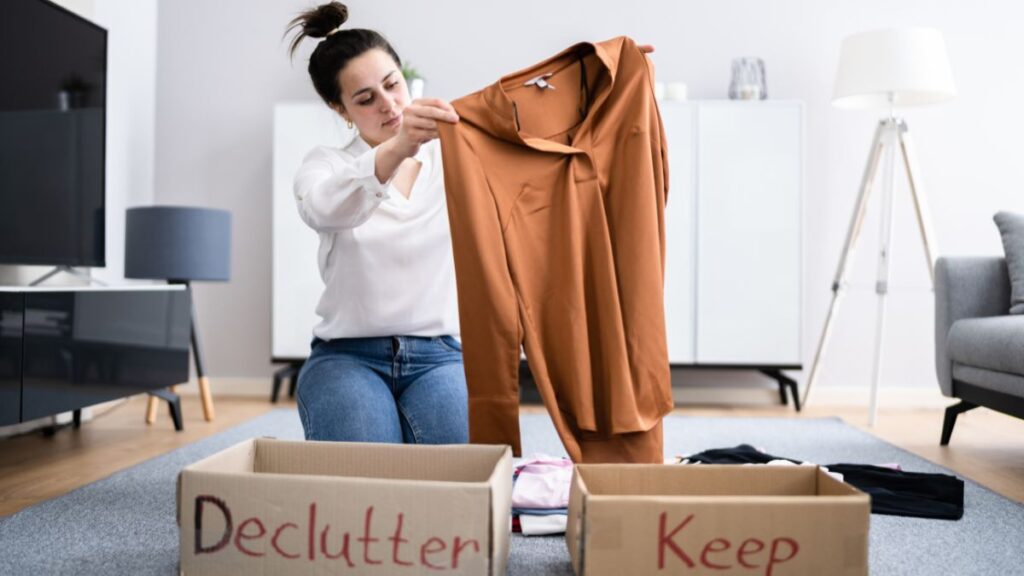
Stacks of old mail, cluttered shelves, overstuffed closets—these sights quietly drain your calm at home. When you decide to tackle a declutter challenge before the year ends, you spark real change. Small shifts over just one week could reframe how you feel indoors.

Autumn Leaf and Gutter Cleaning Made Simple
Prepare your home with our autumn leaf and gutter cleaning guide. Learn time-saving routines, gear tips, and leaf removal tricks for safer, cleaner fall living. Stop wate
The year’s close is a natural cue to revisit what you own and keep only what you enjoy or truly need. Completing a home declutter challenge makes tidying manageable and deeply rewarding. You’ll spot progress fast, and motivation will snowball.
If you feel overwhelmed at the idea of getting started, you’re not alone. This step-by-step declutter challenge gives you clear wins each day, plus practical routines to carry into the new year. Let’s break down exactly what to do.
Day One Setup: Define Your Starting Point and Motivation
Knowing why you’ve chosen to do the declutter challenge creates a stronger sense of purpose from day one. Setting intentions shapes what you’ll tackle and how good finishing will feel.
Grab a notepad or open a phone memo to record your main motivation. Maybe it’s finding your keys with less stress, or wanting calm mornings without searching for a favorite mug.
Clarifying Motivation with a Quick Exercise
Write down three areas that cause you daily frustration. For example, you might jot “messy entryway makes me late,” or “junk drawer hides scissors I need.” State your feelings honestly.
Connecting clutter to real frustrations helps reignite motivation when midweek energy dips. Post your notes somewhere visible, like taping them to the fridge, to keep them front and center.
When a moment of resistance arrives, reread your list. Use it as an energy boost to complete the next small step in your declutter challenge.
Mapping the Week for Realistic Progress
Look over your calendar and pick one space to declutter each day. Sequence items from simplest (like a bathroom drawer) to toughest (like a closet).
Allocate a 20- to 30-minute slot for each day’s task. Short, focused sprints often yield more measurable progress than marathon cleaning sessions—and they’re easier to commit to after work or during a lunch break.
Adjust if needed: If one area needs extra work, plan for a two-day slot. This way your declutter challenge feels supportive, never punishing.
| Day | Area to Tackle | Estimated Time | Takeaway Tip |
|---|---|---|---|
| Day 1 | Entryway surfaces | 20 minutes | Start with small wins for quick momentum |
| Day 2 | Kitchen countertop | 25 minutes | Remove all non-daily appliances |
| Day 3 | Bathroom cabinet | 20 minutes | Keep only essentials and quick-access items |
| Day 4 | Living room shelves | 30 minutes | Display what you love, store the rest |
| Day 5 | Bedroom closet | 35 minutes | Sort clothes by frequency of use |
Focused Approach: Sorting, Staging, and Letting Go with Confidence
Structuring your daily routine with clear boundaries expands what’s possible in a short declutter challenge. The most effective method is to sort, stage, then decide in one session.
Think in terms of function: “Will I use this next year?” If not, staging for removal becomes much easier. Practice being decisive but gentle with yourself.
Spot the Keepers: Trusting Your Instincts Matters
Touch each item and ask if it makes daily life smoother or brings you joy. If not, let it go. For example, holding a worn-out spatula and realizing you always bypass it builds confidence in your choices.
When deciding about sentimental or “someday” items, give yourself 20 seconds per object. A quick yes or no keeps your momentum strong within your declutter challenge.
Place keepers right back in their spot. Place “questionables” in a clearly labeled box—for review at the end of the week.
- Identify one category per session: Focusing on toys, books, or kitchen items avoids overwhelm and tracks your progress in measurable steps.
- Create a donation zone: Pick a bin or corner in the hallway. This visible cue reminds you to deliver items at week’s end.
- Limit daily time: Use a timer for 30 minutes. Stop when it rings to keep your declutter challenge energizing and not exhausting.
- Simplify decisions: Label three bins: keep, donate, toss. Each item must go in one, reducing uncertainty and second-guessing.
- End sessions with a sweep: Bag up items marked “toss” right away and take them outside to prevent backsliding or second-thoughts.
Knowing your boundaries, and seeing bags fill, transforms the abstract goal of decluttering into a visible, daily win.
Implementing the Staging Technique for Easier Letting Go
Lay out your sorted items in three stages: keep, donate, and toss. Place the donate pile straight into your car, basket, or box, out of immediate sight.
Finish each session by restoring only the keepers to their places. Staging keeps you from making piles that linger and weigh you down all week.
- Lay out all items in sight: This visual sweep reduces missed items and clarifies what you truly have on hand.
- Handle gifted items confidently: Remind yourself gifts served a purpose but don’t need to stay forever if no longer useful.
- Bag up trash: Bring a tough trash bag and commit to tossing what’s broken or expired right away.
- Batch your trips: Group all donation bags and schedule one trip at the end of the week. This combines efficiency with a feeling of closure.
- Celebrate each completed stage: Take a before-and-after photo after every session. You’ll appreciate your progress and spark motivation for the next task in your declutter challenge.
Every stage closed brings renewed energy for tomorrow’s micro-task. Momentum powers your full declutter challenge through the week—no backtracking needed.
Midweek Momentum: Keeping Up When Motivation Dips
During any declutter challenge, most people hit a dip in the middle. The excitement of newness fades, but big progress isn’t yet obvious. Structure your days to prevent losing steam.
Use quick, visible wins. For example, cleaning out your entryway or reorganizing kitchen drawers produces instant visual payoff and a cleaner feel in the highest-traffic spaces at home.
Microchecklist: Fast-Action Wins That Reset Your Energy
Use a sticky note to list three five-minute tasks. Tackle them in bursts—a junk drawer, coffee table, or nightstand. Each checked box re-establishes that sense of control and progress in your declutter challenge journey.
The microchecklist method is a reset button. When larger spaces feel overwhelming, focus on these small wins. Even five minutes daily nets a clearer, lighter home by week’s end.
Reward yourself after finishing. Pour a favorite beverage, light a candle, or take a quick break as a mini celebration.
Scenario: When You’re Stuck Making Decisions
You’re holding a sweater you haven’t worn all year. Instead of “maybe someday,” tell yourself, “If I needed it this winter, I’d have worn it already.” Confidence grows with every firm choice.
Switch from “what if I need this?” to “would I replace this if it were lost today?” This clear rule trims irrational second-guessing and keeps the declutter challenge moving forward.
Revisit your motivation list taped to the fridge. Remind yourself of the concrete gains you’ll see by week’s end—space, time, and a peaceful environment.
Dealing with Sentimental Items: Keep Only What Serves Your Life Now
Decluttering sentimental things brings up complex emotions. If these objects overwhelm your sense of calm at home, set a clear rule: select a few to honor, and let the others go.
Gather all such items in one visible spot before deciding. Seeing everything at once reduces the tendency to squirrel things away “just in case.”
Mini Process for Sorting Sentimental Objects
For every item, ask what story or feeling it carries. If you smile or feel a strong connection, that’s a keeper. If not, it’s safe to release it to a new home.
Set a numeric limit. “I’ll keep ten holiday cards, and let the rest go.” Rules like this reduce the guilt or worry about being disrespectful to memories.
Document treasures before letting go. Take digital photos of children’s artwork or old programs, or write a note about items that mattered most to you. Then release them without regret.
Reduce Decision Fatigue: One Small Box Rule
Grab a shoebox or decorative container. Fill that single box with only your favorite mementos: one team jersey, a few travel keepsakes, cherished letters.
This boundary sharpens decisions about what’s truly precious. Over time, you’ll appreciate revisiting a small box of meaningful objects rather than dealing with overflowing bins.
When the box is full, revisit it each year as you refresh your declutter challenge, passing along or recycling pieces that no longer spark emotion.
Reorganize for Easy Upkeep: Smart Systems to Sustain Order
After the major declutter challenge is done, put in place easy systems to help you maintain the clarity you’ve gained. Design every storage solution for function first, not looks alone.
See daily-used items as “prime real estate.” Place frequently grabbed things in the front or most accessible areas, and less-used objects in higher cabinets or storage bins behind.
- Give everything a home: Assign a unique spot for keys, mail, bags, and phone chargers. This stops clutter from landing where it doesn’t belong.
- Stick to visible containers: Clear boxes, baskets, or labeled trays let you spot what’s inside instantly, reducing search time and duplication of supplies.
- Group by activity: Keep breakfast ingredients together or gather pet supplies in a small tote. This analogy—tools in a toolbox—means grabbing what you need is one smooth movement rather than five scattered searches.
- Install hooks and small shelves: Wall-mounted hooks for purses, jackets, or bath towels invite consistent placement and a less cluttered floor.
- End each week with a ‘reset session’: Every Sunday, return things to their homes as part of your maintenance. This micro-routine cements order with almost no extra effort.
These micro-systems keep your declutter challenge’s results durable month after month, limiting the need to start over in the future.
Reset Your Home and Mind for a Fresh Start
Completing a declutter challenge does more than lighten your home—it clarifies your routines and reduces daily friction. When every item has a purpose and place, even rushed mornings move more smoothly.
By reviewing your starting list and walking through the week step-by-step, you’ll see tangible gains: less time spent hunting for lost objects and more room to enjoy being at home.
This process helps you create a practical foundation for any other home improvements you plan next year. Return to your notes and routines whenever clutter begins to return—each year’s end can bring a renewed sense of control and comfort.
Frequently Asked Questions
Place questionable items in a labeled “Maybe” box. At the end of your 7-day declutter challenge, revisit the box. If you haven’t needed or missed something, it’s usually safe to donate or toss it.
Set clear boundaries—a shared zone for joint decisions and personal zones each person handles solo. Use “keep, donate, toss” bins for efficiency, and respect each person’s comfort speed in the process.
Research local charities or shelters before you start. Place donation bags straight into your car or an entryway bin to avoid second-guessing. Schedule a delivery at the end of your declutter challenge week.
Give every item a specific home, use clear containers, and reset once a week. If something new comes in, let another item go—a consistent “one in, one out” rule keeps order over time.
Yes, by focusing on bite-sized tasks and completing visible zones, your home stays noticeably lighter and more welcoming. Visible wins each day help build routines that prevent future clutter.

Refrigerator Deep Sanitize
Sanitize your fridge before the summer heat. Learn expert refrigerator cleaning tips, simple organizing tricks and odor-fighting solutions for a fresh, food-safe fridge a


